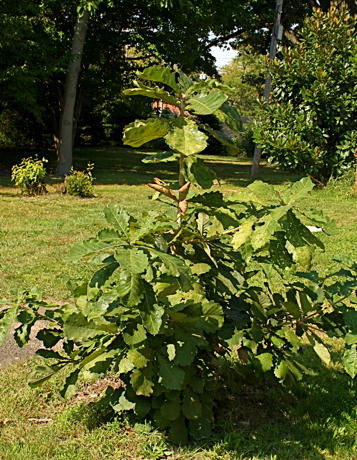Eric’s Pet Plant: Daimyo Oak (Quercus dentata)
There are a lot of oak trees in the woods around us in Maine, some white oaks, some reds, some still sapling size, some close to majestic. They’re nice in their way (especially when adorned with hen of the woods mushrooms), but they’re almost as much of a nuisance as Norway maples. The acorns root readily almost everywhere they land and thanks to the squrrels they land pretty much everywhere.
In other words, we are already if anything oversupplied with oaks, and until I read about Eric’s Daimyo I felt no need to plant more. But now, I dunno. He does make his tree sound very appealing, and a simple google delivers a lot of enticing images. (Many of them are for Daimyo oak bonsai, who knew?)
Quercus dentata (Daimyo Oak)
By Eric Larson
One of the best parts of my job working here at Yale’s Marsh Botanical Garden is that I get to think fifty years down the road. On the problematic side, Global Warming. On the more encouraging one, white oaks, which generally are very slow growing.
Taken as a whole, the white oak group is persnickety about transplanting. The trees develop tap roots at a very young age, and this makes them poor candidates for nurseries to grow or homeowners to buy. I have seen fifteen to twenty foot swamp white oaks for sale at specialty nurseries, but such trees are highly vulnerable to transplant shock and the shock is often so severe they never recover.
It’s much better to plant very small white oaks; there are many sources for two- or three-year old saplings. In fact, planting acorns is easiest and would be ideal if it weren’t for the squirrels (I have had squirrels dig first year oak saplings to get at the nut).
Planting a three-year old sapling does give you a small head start, but even that is an exercise in humility and patience. Humility in knowing that our fleeting time on earth represents unbridled youth for a white oak, patience in waiting for it to begin to put on its teenage bulk.
When I say “white oak group members,” I mean as opposed to the other predominant oak group, which I refer to as the red oak group. There are others: the cerros oak group and what is often called the “intermediate” group, but for us in the northern U.S., it’s basically red and white, like wines if you will.
Red oaks have leaves with pointed lobes, and very bitter acorns. White oaks have leaves with rounded lobes, and acorns that are either sweet or only slightly bitter. The white oaks include Q. alba, of course, but also swamp white oak (Q. bicolor), the post oak (Q. stellata), the burr oak (Q. macrocarpa), the swamp chestnut oak (Q. michauxii), the chinkapin oak (Q. muehlenbergii), the chestnut oak (Q. prinus) and many, many others, from almost all continents. The Daimyo (Q. dentata) is a native of Japan, Korea and China, and somewhat rare in these parts.
I planted ours five years ago. Then, in its second year, it had an unfortunate meeting with a large mower. This resulted in it being pollarded completely to the ground, much to my chagrin. I was actually in the area and watched the event, totally dumbstruck until afterwards (as usual, thinking retroactively).
So I gave a quick ‘tutorial’ to the fellow riding the lawn mower and then staked the stump – which started growing back almost immediately – more forcefully, with orange and yellow banners aflutter as if it were a Tibetan prayer flag.
The Daimyo Oak is a fairly large tree in its native range, growing to over 80 feet tall, but under cultivation we can expect a smaller specimen, perhaps to sixty feet. The leaves are the largest of any of the oaks, reaching up to fifteen inches in length. They are downy on both sides, but gradually lose the short soft hair on the top of the leaf.

This foot-wide lens cap gives an idea of the size of the leaves. Only kidding, but still a wonderfully large leaf. I’m sure that Adam would have loved to have a Daimyo Oak about after The Fall.
One aspect that I really like about the daimyo oak is that the stems are also hairy, which adds a very nice winter interest to this rather irregularly shaped tree.

Hard to see the down on the stem, but it’s there, almost like stag-horn sumac hair, a subtle but wonderful characteristic.
Like many oaks, the Daimyo eventually reaches a stage where its general aspect is a globe, but in the meantime patience is required; one must put up with a bit of teenage charm, aka some awkward looking profiles.
Plant Daimyo oak in full sun and well-drained average soil. It will do well once the lawn mowers leave it alone, and it will reward you with years of carefree conversation initiation. It really is out of the ordinary, even to the unpracticed and unhorticultural eye.
















Get a Trackback link